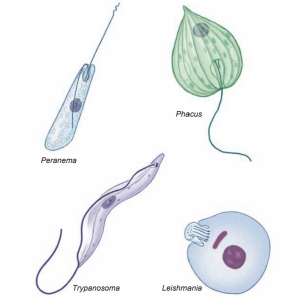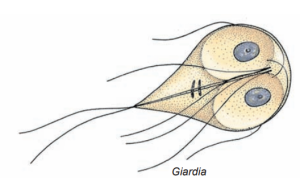The Euglenozoa is generally considered a monophyletic group, based on the shared persistence of the nucleoli during mitosis, and the presence of discoid mitochondrial cristae. Members of this phylum have a series of longitudinal microtubules just beneath the cell membrane that help to stiffen the membrane into a pellicle. The phylum is divided into two subphyla, the Euglenida and the Kinetoplasta. Kinetoplastans are named for the presence of a unique organelle, the kinetoplast. This modified mitochondrion, associated with a kinetosome, carries a large disc of DNA. Kinetoplastans are all parasites, living in plants and animals.

Subphylum Euglenida
Euglenids, formerly in the Phytomastigophorea, have chloroplasts with chlorophyll b. These chloroplasts are surrounded by a double membrane and are likely to have arisen via secondary endosymbiosis.
Euglena viridis is a representative flagellate commonly studied in introductory zoology courses. Its natural habitat is freshwater streams and ponds where there is considerable vegetation. The organisms are spindle shaped and about 60 µm long, but some species of Euglena are smaller and some larger (E. oxyuris is 500 µm long). Just beneath the outer membrane of Euglena are proteinaceous strips and microtubules that form a pellicle. In Euglena the pellicle is flexible enough to permit bending, but in other euglenids it may be more rigid. A flagellum extends from a flask-shaped reservoir at the anterior end, and another, short flagellum ends within the reservoir. A kinetosome occurs at the base of each flagellum, and a contractile vacuole empties into the reservoir. A red eyespot, or stigma, apparently functions in orientation to light. Within the cytoplasm are oval chloroplasts that bear chlorophyll and give the organism its greenish color. Paramylon granules of various shapes are masses of a starchlike food storage material.
Nutrition of Euglena is normally autotrophic (holophytic), but if kept in the dark the organism uses saprozoic nutrition, absorbing nutrients through its body surface. Mutants of Euglena can be produced that have permanently lost their photosynthetic ability. Although Euglena does not ingest solid food, some euglenids are phagotrophic. Peranema has a cytostome that opens alongside its flagellar reservoir.
Euglena reproduces by binary fission and can encyst to survive adverse environmental conditions.
Subphylum Kinetoplasta
Some of the most important protozoan parasites are kinetoplastans. Many of them belong to the genus Trypanosoma (Gr. trypanon, auger, + soma, body) and live in the blood of fish, amphibians, reptiles, birds, and mammals. Some are nonpathogenic, but others produce severe diseases in humans and domestic animals. Trypanosoma brucei gambiense and T. brucei rhodesiense cause African sleeping sickness in humans, and T. brucei brucei causes a related disease in domestic animals. Trypanosomes are transmitted by tsetse flies (Glossina spp.). Trypanosoma b. rhodesiense, the more virulent of the sleeping sickness trypanosomes, and T. b. brucei have natural reservoirs (antelope and other wild mammals) that are apparently not harmed by the parasites. Some 10,000 new cases of human sleeping sickness are diagnosed each year, of which about half are fatal, and many of the remainder sustain permanent brain damage.

Trypanosoma cruzi causes Chagas’ disease in humans in Central America and South America. It is transmitted by “kissing bugs” (Triatominae), a name arising from the bug’s habit of biting its sleeping victim on the face. Acute Chagas’ disease is most common and severe among children less than five years old, while the chronic disease is seen most often in adults. Symptoms are primarily a result of central and peripheral nervous dysfunction. Two to three million people in South and Central America show chronic Chagas’ disease, and 45,000 of these die each year.
Several species of Leishmania cause disease in humans. Infection with some species may cause a serious visceral disease affecting especially the liver and spleen; others can cause disfiguring lesions in the mucous membranes of the nose and throat, and the least serious result is a skin ulcer. Leishmania spp. are transmitted by sand flies. Visceral leishmaniasis and cutaneous leishmaniasis are common in parts of Africa and Asia, and the mucocutaneous form occurs in Central America and South America.
Useful External Links
- Euglenozoa: taxonomy, diversity and ecology, symbioses and viruses by The Royal Society
- Euglenozoa by BIONITY.COM
- Euglenozoa by University of CHICAGO


